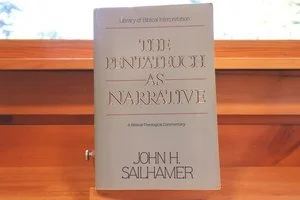Unveiling the Story of Scripture: Sailhamer's Narrative Approach to the Pentateuch
John H. Sailhamer’s The Pentateuch as Narrative is recognized as a significant contribution to biblical studies, particularly for its innovative approach to reading the Torah as a unified, theological narrative rather than a collection of separate texts or legal codes. Sailhamer invites readers to view the Pentateuch as a coherent story designed to convey theological meaning, with a particular focus on God’s promises and covenant with Israel. Whereas “The Meaning of the Pentateuch” by Sailhamer is written in a way where he addresses Biblical topics, this one is written more like a commentary on the Pentateuch (Torah) text.
John H. Sailhamer's "The Pentateuch as Narrative: A Biblical-Theological Commentary" offers a groundbreaking approach to reading the first five books of the Bible. Published in 1992 by Zondervan, this work invites readers to view the Pentateuch not just as a collection of laws and historical records but as a cohesive narrative with profound theological implications. This article explores the essence, methodology, and impact of Sailhamer's commentary.
Key Features:
Narrative Approach: Sailhamer highlights the literary unity of Genesis through Deuteronomy. He argues that the Pentateuch was structuredto focus on the promise of the land and the future seed, which eventually culminates in the hope for a Messiah. This approach emphasizes the narrative aspect rather than breaking the text down into separate historical or legal parts. Instead of dissecting the text into its historical or legal components, Sailhamer reads the Pentateuch as a single narrative, emphasizing its literary unity. This approach highlights how the story unfolds from Genesis to Deuteronomy, linking characters, events, and themes.
Theological Focus:
The book suggests that the Pentateuch’s primary purpose is not to provide a detailed history or legal manual but to present a theological message centered on God's covenant and mankind’s justification with God through faith. Sailhamer underscores the importance of understanding how the Torah directs readers' attention to future fulfillment in the New Covenant. The commentary is deeply theological, aiming to uncover the author's (Mosaic) intent and the text's divine message. Sailhamer explores how the narrative of the Pentateuch points to the Messiah, the fulfillment of God's promises, and the covenant relationship between God and His people.Canonical Perspective:
Sailhamer places the Pentateuch within the larger framework of the Hebrew Bible and emphasizes its role in pointing forward to the prophetic and messianic hope seen in later biblical books. His work is especially appreciated for drawing connections between the Torah and the broader canon of Scripture. Sailhamer insists on interpreting the Pentateuch within the broader context of the entire Hebrew Bible, suggesting that later scriptures often reference or fulfill earlier ones, thus advocating for a unified biblical theology.Literary Analysis: He pays close attention to literary devices like repetition, structure, and the placement of texts within the narrative to reveal theological truths.
Strengths:
Readable and Accessible: Despite dealing with complex theological and literary concepts, Sailhamer writes in a way that is accessible to both scholars and lay readers.
Christological Implications: Sailhamer’s work offers a rich Christological interpretation, showing how the Pentateuch anticipates the New Testament.
Overview of the Work
Sailhamer's book provides a fresh perspective by treating the Pentateuch as an integrated story, focusing on its literary structure, theological themes, and the overarching message it conveys about God's plan of redemption.
Significance in Biblical Studies:
Shift in Methodology: Sailhamer's work represents a shift from source criticism, which often fragments the text, to a holistic narrative approach, which respects the text's final form.
Biblical Theology: His commentary helps bridge the gap between Old and New Testaments, showing how the Pentateuch sets up themes and promises that find their fulfillment in Christ, thus enriching Christian theology.
Educational Resource: It serves as an important text for theological education, offering students a method for reading Scripture that emphasizes its narrative and theological coherence.
Structure and Content:
Introduction: Sailhamer lays out his methodology, arguing for the Pentateuch's narrative unity and theological purpose.
Commentary on Each Book:
Genesis: Focuses on beginnings, promises, and the theme of redemption through a chosen family.
Exodus: Emphasizes liberation, covenant, and the law as part of God's redemptive plan.
Leviticus: Explores the holiness of God and the means for humans to approach Him.
Numbers: Looks at the journey through the wilderness as a metaphor for the Christian life.
Deuteronomy: Stresses the covenant renewal, the call to obedience, and the prophetic look forward to God's ultimate plan through the Messiah.
Conclusion: Summarizes the narrative's theological trajectory and its implications for understanding the rest of Scripture.
Impact and Reception:
Academic Influence: Sailhamer's narrative approach has influenced biblical studies by encouraging a reading of the Bible that respects its literary qualities and theological unity.
Controversial Aspects: Some scholars might challenge his assumptions about single authorship or his emphasis on certain interpretations over others. However, his work has been lauded for its insight into the text's narrative and theological dimensions.
Practical Application: Pastors, theologians, and laypeople have found this commentary useful for preaching, teaching, and personal Bible study, offering a way to understand the Old Testament that feels more connected to the New Testament's teachings.
"The Pentateuch as Narrative" by John H. Sailhamer is more than a commentary; it's an invitation to experience the Bible's foundational texts in a new light. By focusing on the narrative flow, Sailhamer not only illuminates the theological richness of the Pentateuch but also provides a model for reading the Bible that underscores its unity and purpose. His work remains a significant contribution to biblical scholarship, encouraging a deeper, more integrated understanding of Scripture's story from creation to covenant.
The Pentateuch as Narrative is a valuable resource for those interested in the literary and theological dimensions of the Torah. It challenges readers to think beyond traditional historical-critical methods and instead consider the Pentateuch as a carefully crafted narrative with profound theological significance. This is a very thought-provoking commentary on the Torah.

